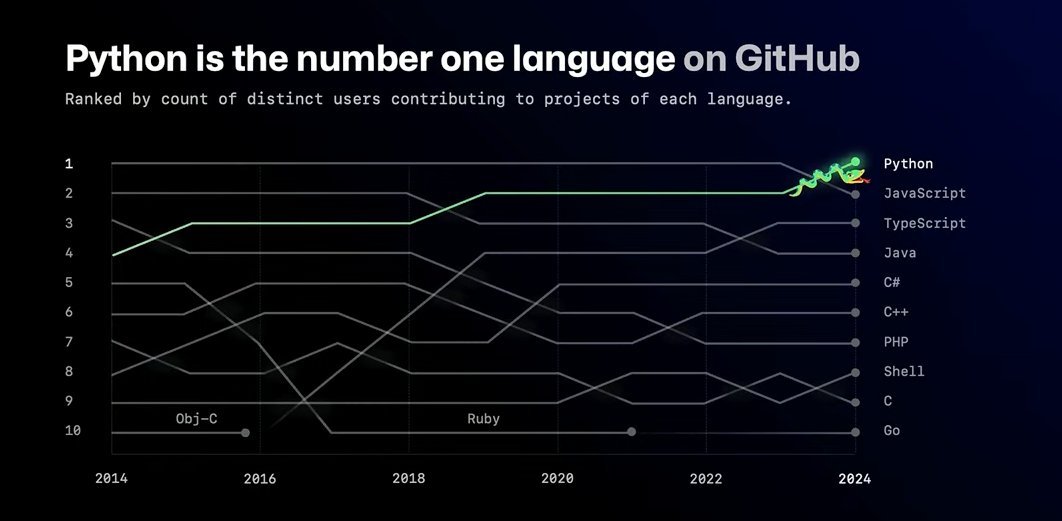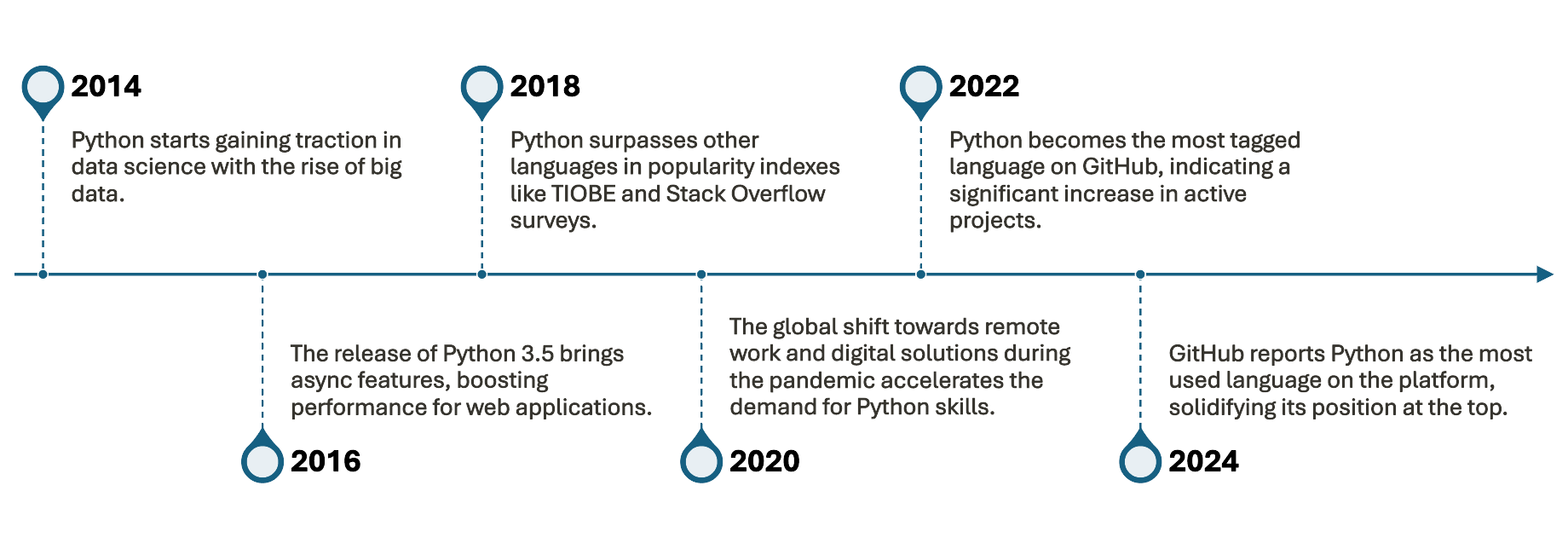Python Rises as GitHub's Most Popular Language (2014-2024)

In the past decade, the programming landscape has shifted dramatically. Languages that once dominated the scene are now sharing the spotlight—or even stepping aside—for newer, more versatile contenders. At the center of this shift is Python, a language that has not only stood the test of time but has soared to unprecedented heights. From 2014 to 2024, Python has climbed the ranks to become GitHub's most popular language, and it's not just by chance.
The Problem: Navigating the Complexities of Modern Programming
Developers worldwide have grappled with the complexities of traditional programming languages. Languages like Java and C++ offer power and performance but often come with steep learning curves and verbose syntax. As technology advances, the demand for rapid development, readability, and versatility becomes more pressing. Developers are seeking languages that can handle everything from web development to data analysis without getting bogged down in intricate code.
The Struggle with Traditional Languages
Traditional languages, while robust, often require extensive boilerplate code. This not only slows down development but also makes maintenance a headache. Newcomers to programming can find themselves overwhelmed by these complexities, potentially hindering the influx of fresh talent into the development community.
The Impact on Innovation
When developers spend more time wrestling with the language than solving problems, innovation suffers. Projects take longer to complete, and the opportunity cost of delayed deployment can be significant. The need for a language that promotes efficiency and readability is more critical than ever.
The Solution: Python's Simplicity and Power
Enter Python—a language that strikes a balance between simplicity and functionality. Python's clean syntax and readability lower the barrier to entry for new programmers while providing seasoned developers with the tools they need to build complex applications.
Why Python Stands Out
Python's philosophy emphasizes code readability and simplicity. Its syntax is straightforward, using indentation to define code blocks instead of curly braces or keywords, which makes the code visually uncluttered.
But don't let its simplicity fool you. Python is a powerhouse capable of handling a multitude of tasks:
| Web Development | Frameworks like Django and Flask make web development a breeze. |
|---|---|
| Data Science and Machine Learning | Libraries such as NumPy, Pandas, and TensorFlow have made Python the go-to language for data professionals. |
| Automation and Scripting | Python excels at automating repetitive tasks, increasing efficiency. |
| Education | Its simplicity makes it an ideal first language for beginners, fostering a new generation of developers. |
Python's Journey to the Top: A Decade of Growth
The period from 2014 to 2024 has been monumental for Python. Let's delve into the factors that contributed to its meteoric rise on GitHub.
Key Milestones

Community and Ecosystem
Python's vibrant community has been a cornerstone of its growth. The open-source nature of Python has led to the development of numerous libraries and frameworks, extending its capabilities and applications.
Comparing Python with Other Languages
To understand Python's dominance, let's compare it with other popular programming languages.
| Feature | Python | Java | JavaScript | C++ |
|---|---|---|---|---|
| Syntax Simplicity | Simple and readable | Verbose and stricter | Moderate | Complex and detailed |
| Use Cases | General-purpose: web, data, AI | Enterprise applications | Web and mobile apps | System/software development |
| Learning Curve | Gentle | Steeper | Moderate | Steep |
| Community Support | Extensive | Extensive | Extensive | Strong but niche |
| Performance | Interpreted, slower than compiled | Compiled, faster | Interpreted, moderate | Compiled, high performance |
| Library Support | Vast ecosystem | Robust standard libraries | Rich in web frameworks | Comprehensive but complex |
As the table illustrates, Python offers a unique combination of simplicity and versatility that appeals to a wide range of developers.
Python in Various Fields
Python's adaptability has allowed it to penetrate multiple industries.
Data Science and Machine Learning
The surge in data-driven decision-making has put Python at the forefront. With libraries like Scikit-learn for machine learning and Matplotlib for data visualization, Python provides a comprehensive toolkit for data professionals.
Web Development
Frameworks such as Django and Flask have made Python a strong contender in web development. Django, in particular, follows the "batteries-included" philosophy, offering ready-to-use components that accelerate development.
Automation and Scripting
Python's ease of use makes it ideal for scripting and automating tasks. IT professionals leverage Python scripts to manage system operations, automate backups, and perform network automation tasks.
Education
Educational institutions have adopted Python as the primary language for teaching programming concepts. Its readability helps students grasp fundamental concepts without getting bogged down in syntax.
The Future of Python
Looking ahead, Python shows no signs of slowing down.
Emerging Trends
- Artificial Intelligence: Python will continue to be integral in AI development, especially with advancements in deep learning.
- Internet of Things (IoT): MicroPython and CircuitPython are bringing Python to hardware programming.
- Education: As more educational tools and platforms adopt Python, we'll see a new wave of programmers entering the field.
Potential Challenges
- Performance: While Python is versatile, it's not the fastest language. Projects requiring high performance might opt for alternatives unless Python addresses these concerns.
- Version Fragmentation: The coexistence of Python 2.7 and Python 3.x has caused confusion in the past, but with Python 2.7's end of life, this issue is diminishing.
Conclusion: Python's Place at the Pinnacle
Over the past decade, Python has not just risen to prominence; it has reshaped the programming world. Its blend of simplicity, power, and community support has addressed the pressing problems developers faced with traditional languages.
By easing the complexities of coding and fostering innovation, Python has earned its spot as GitHub's most popular language from 2014 to 2024. Whether you're a seasoned developer or just starting, Python offers a treasure trove of possibilities.
So, if you haven't already dabbled in Python, now's the time. Join the vibrant community, contribute to exciting projects, and be part of the language that's defining the future of programming.
Author's Note: This article aims to provide insights into Python's rise and its impact on the programming community. The statistics mentioned are illustrative, reflecting industry trends over the past decade.